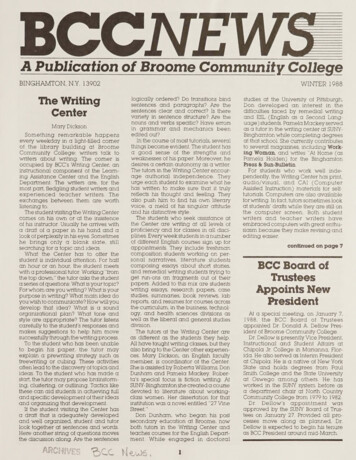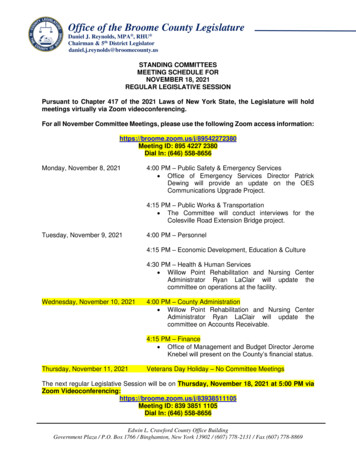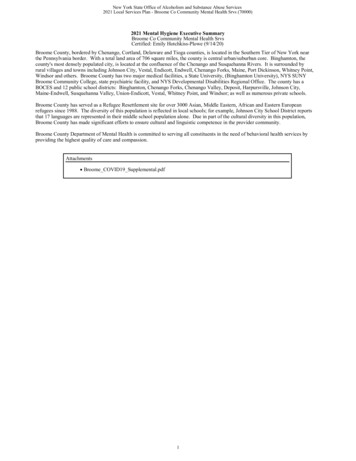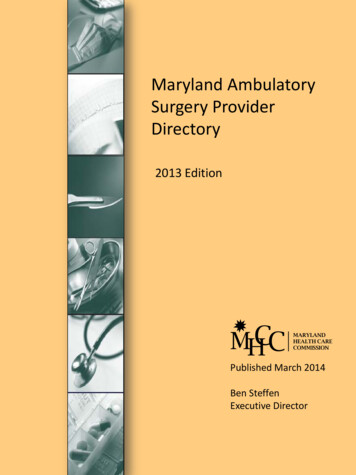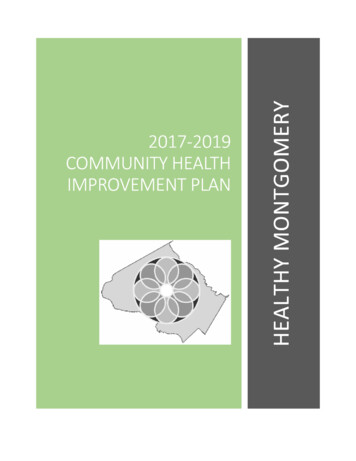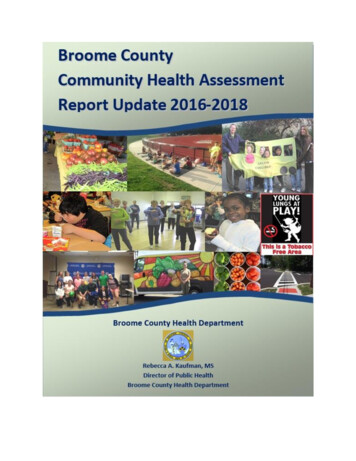
Transcription
AcknowledgementsOn behalf of the residents of Broome County, we are pleased to present theBroome County Community Health Assessment 2016-2018 UpdateWe hope that it serves to improve the health and well-being of all residents of Broome County.With gratitude to the following individuals for their service on and contributions to the Broome CountyCommunity Health Assessment 2016-2018 Steering Committee:Binghamton Housing Authority – Elaine MillerBinghamton University – Leon Cosler, Diane Crews, Yvonne Johnston, Titlayoi OkororBroome County Council of Churches – Michael LeaheyBroome County Health Department – Mary McFadden, Dr. Christopher RyanBroome County Legislature – Kim Myers, Kelly WildonerBroome County Mental Health Department – Lynne EsquivelBroome County Office for Aging – Rita Fluharty, Jamie KellyBroome County Planning Department – Stephanie BrewerBroome Tioga BOCES – Alan BuyckBroome County Urban League – Jennifer LeskoBroome County YMCA – Aubrey Carr, Alice Harper, Gareth SansomCornerstone Family Healthcare – Marianne Buck, Kelly WildeyExcellus Blue Cross Blue Shield – Melissa KlinkoFamily and Children’s Society – Lisa HoescheleGuthrie Medical Group, PC – Shawn Karney, Hillary Saxton, Sherry SalisburyHealthlinkNY – Adam HughesMental Health Association of the Southern Tier – Kathy EckertMothers and Babies Perinatal Network – Christy FinchOur Lady of Lourdes Hospital – Deborah Blakeney, Lisa Bobby, Carmen Francavilla, WayneMitteer, Jeffrey PenoyerRural Health Network of SCNY – Pam Guth, Emily Hotchkiss, Mary Maruscak, Jack SaloSouthern Tier Independence Center – Susan RuffSUNY Upstate Medical University Clinical Campus at Binghamton – Lenore BorisTioga County Health Department – Rebecca Kaufman, Heather MorganUnited Health Services Hospitals – Karen Bayer, Scott Hall, Robin Kinslow-EvansWEBB Consulting – Lea WebbThis report was prepared and submitted by the Broome County Community Health AssessmentCoordinator, Yvonne Johnston, DrPH, MPH, MS, RN, FNP. Questions or comments should be directed to:Dr. Yvonne Johnston, Research Associate ProfessorDecker School of Nursing, Binghamton University, PO Box 6000, Binghamton, NY 13902-6000E-mail: johnston@binghamton.eduWith grateful acknowledgement to the Broome County Health Department for their administrative supportand in particular, to Mary McFadden, Deputy DirectorChelsea Reome, MPA and Aimee Grace, MPH, Public Health Representativesas well as Diana Wilson, Secretaryfor their substantive contributions to the preparation of this report.ii
Broome CountyCommunity Health Assessment (CHA)Community Health Improvement Plan (CHIP)and Community Service Plan (CSP)2016 - 2018 UpdateCounty covered:Broome CountyParticipating Local HealthDepartment:Broome County Health DepartmentParticipating Hospitals:Our Lady of Lourdes Memorial Hospital, Inc.225 Front Street, Binghamton, NY 13905Phone: 607-778-3930 FAX: 607-778-2838Web: www.gobroomecounty.com/hd169 Riverside Drive, Binghamton, NY 13905Phone: 607-798-5111Web: www.lourdes.comUnited Health Services Hospitals, Inc. UHS Wilson Medical Center33-57 Harrison Street, Johnson City, NY 13790Phone: 607-763-6000 UHS Binghamton General Hospital10-42 Mitchell Avenue , Binghamton, NY 13903Phone: 607-762-2200 UHS Medical Group40 Arch Street, Johnson City, NY 13790Phone: 607-763-6293Web: http://www.uhs.net/Coalition/entity completingassessment and plan:Broome County Health Departmentiii
iv
Executive SummaryOver the past year, the Broome County Health Department, United Health Services (UHS) andOur Lady of Lourdes Hospital have conducted a systematic and comprehensive process thatembraced community engagement, education, data retrieval and analysis, and a documenteddecision-making process in order to update the Broome County Community Health Assessment(CHA) and Community Health Improvement Plan (CHIP) for the 2016-2018 period. This endeavorrelied on multisector collaboration. The process also was informed by analyzing theimplementation efforts and performance measures for the 2013-2017 CHIP. This organizedapproach resulted in the Steering Committee voting to continue work on the same threePrevention Agenda priority areas: Promote a Healthy and Safe Environment Prevent Chronic Disease Promote Mental Health and Prevent Substance AbuseIn addition, the Broome County CHA Steering Committee has chosen to focus on the healthdisparities encountered by the low income, Medicaid population and particularly on individualswho underutilize the preventive and disease management services within the health caresystem.The process reaffirmed the need for continued efforts to address community priorities thatwere selected in 2013. Since the last priority setting phase, there has been an unprecedentedhealthcare system transformation underway generated by NYS Medicaid redesign and reform.This venture, the Delivery System Reform Incentive Program (DSRIP), allows New York State toreinvest billions in federal savings to alter the financing and delivery of health care with the goalof reducing hospitalizations from preventable conditions. This project targets low utilizers ofthe Medicaid system who do not endorse prevention, nor understand self-management aspectsof chronic diseases, and who frequently use emergency rooms for preventive services. Whilethis driving force in healthcare has not changed the priority areas per say, it has influenced thedevelopment of a new intervention strategy designed to impact the mental health priority areaand align with the larger health system transformation.Two additional emerging health issues in Broome County are highly linked to the socialdeterminants of health: food insecurity and opioid abuse. These issues have been adopted bycommunity “grass roots” taskforce groups. Members of these alliances continue to examinelocal data, explore evidence based interventions, consult with experts and knowledgeableprofessionals, and meet with community members personally affected by these problems. Thecommon goal of these coalitions is to develop an evidence based, multifaceted approach thatwill inform the next five-year CHA/CHIP process. Many Broome County CHA SteeringCommittee Members serve in some capacity or have representation on these groups.A broad set of data sources were reviewed to assess progress, identify ongoing or new healthissues, and inform strategic prioritization of needs for this report including:v
State and Federal: US Census Bureau American Community Survey, NYS PreventionAgenda Dashboard, NYS Expanded Behavioral Risk Factor Surveillance System (eBRFSS)Survey, NYS Quality Assurance Reporting Requirements (QUARR), Network, NYSCommunity Health Indicators Reports, NYS Vital Statistics, NYS Sub-County Health DataReport for County Health Rankings-Related MeasuresFoundations and Community Organizations: Robert Wood Johnson Foundation CountyHealth Ranking, Rural Broome Counts Needs Assessment, NYS Population HealthImprovement Project (PHIP) Community Dashboard (HealthlinkNY)Local Performance Measures: (NYSDOH Grant Funded Programs): Older Adult FallPrevention Program, Community Transformation Grant, Comprehensive Cancer ControlProgram, Creating Healthy Schools and Communities GrantLocal Agency Reports: Broome County Women Infants and Children’s (WIC)Breastfeeding Initiation Report, Medicaid Health Home data (Catholic Charities andUnited Health Service), DSRIP (Care Compass Network) Community Health NeedsAssessment, and various partner specific reports provided by Lourdes and United HealthServices Hospitals.As part of the ongoing process of Mobilizing Action for Planning and Partnerships (MAPP),the Broome County Health Department collaborated with a host of stakeholders whorepresent the county’s multiple sectors and priority populations. Each partner bringsresources, expertise and perspective to specific priority areas. Promote a Healthy and Safe Environment - Focus Area: Reduce Falls andHospitalizations from Falls in Older Adults: United Health Services and Lourdes providedata, technology, staffing, on-site evidence based community programming, referrals,and evaluation information. Independence Awareness, YMCA, Retired Senior VolunteerProgram and Broome County Office for Aging, provide data, staffing resources, space,on-site evidence based community programming, earned media, and evaluationinformation. Excellus Blue Cross Blue Shield provides funding for the expansion ofclinical and community based interventions. Prevent Chronic Disease - Focus Area: Reduce Obesity in Children and Adults andFocus Area: Incorporate Access to High Quality Chronic Preventive Care andManagement in Both Clinical and Community Settings: Broome County WIC Programand Maternal Child Health, Mothers and Babies Perinatal Network, and the SouthernTier Breastfeeding Coalition provide data, conduct evidence based healthy lifestylecounseling, offer breastfeeding education for health care providers and families, andimplement the breastfeeding peer counseling program. Lourdes, United Health Services,Binghamton University, Rural Health Network, Family Enrichment Network, BroomeCounty Council of Churches, Broome County School Districts, Broome Tioga BOCES,Cornell Cooperative Extension, Binghamton Metropolitan Transportation Study, and theSouthern Tier Independence Center provide data, technology, staffing, on-site evidencebased community programming as well as policy development, implementation,evaluation, and sustainability activities.vi
Promote Mental Health and Prevent Substance Abuse - Focus Area: StrengthenInfrastructure Across Systems: As part of the DSRIP Project 3ai, assessment assets wereprovided to assist with the CHA process and intervention selection. Lourdes is providingresources to assure training and staffing needs will be met to integrate behavioralhealth into primary care.The community-at-large has been engaged in these efforts using various methods of outreachand program evaluation activities. The Broome County Health Department, hospital systems,and CHA Steering Committee members have also been involved with the DSRIP communityengagement efforts. These engagement activities include intercept interviews, focus groups,telephone interviews and community forums. The demographic and geographic lenses fromthese activities proved invaluable for informing the CHA/CHIP process.In general, the evidence-based interventions being implemented are a continuation of theoriginal interventions selected by the Steering Committee in 2013. These interventions wereselected based on potential impact, available resources, measurability, and sustainability. Promote a Safe and Healthy Environment: The Centers for Disease Control and Prevention’s(CDC) Compendium of Effective Fall Interventions Guide represents a comprehensive array ofevidenced based fall prevention interventions for older adults. Broome County chose toimplement both community and clinical interventions. The community based interventionsare Tai Chi Moving for Better Balance and the Stepping On Program. Clinical interventionsare CDC’s Stopping Elderly Accidents, Deaths and Injuries (STEADI) Clinical Fall RiskAssessment Program and a home based physical therapy program (OTAGO). Prevent Chronic Disease: Evidence based interventions were selected from the CDCRecommended Community Strategies and Measurements to Prevent Obesity in the UnitedStates: Implementation and Measurement Guide. The interventions consist of developingand implementing Complete Streets policies, breastfeeding and baby friendly policies,strengthening school wellness policies, reducing screen time and consumption of sugarybeverages, integrating breakfast and physical activity in the classroom, adopting structuredand age appropriate physical activity in daycare settings, implementing pediatric BMIscreening and referral for nutrition and behavioral counseling and implementingbreastfeeding peer support and education programs for WIC families, increasingdiabetes/cardiovascular screening rates and disease management for Medicaid anddisparate populations. Promote Mental Health and Prevent Substance Abuse: Integrating behavioral health intoprimary care practices was chosen for this priority area. The intervention was developed byNew York State and approved by the Centers for Medicare and Medicaid for use byPerforming Provider Systems to develop DSRIP Project Plans.Community health improvement and progress are being monitored by monthly the CHASteering Committee during monthly meetings. In addition, a CHA/CHIP tracking tool wasdeveloped using the process measures from each priority/focus area to inform progress. As theupdated CHIP is implemented and evaluated, specific actions/interventions may be modifiedvii
and new ones added in a continuous and dynamic Plan, Do, Check, Act (PDCA) cycle. The CHIPprocess measures are as follows: Promote a Safe and Healthy Environment: System changes consist of implementing clinicalfall risk assessments in health care setting and implementing a home based physical therapyprogram that integrates fall prevention activities. Process measures include: number ofprimary care sites and providers trained in clinical fall risk assessments, number of patientsscreened, number of patients at risk, number of patients with a fall plan of care, number ofphysical therapists trained in OTAGO, number of patients receiving in-home fall preventionservices, number of Tai Chi and Stepping On community based programs. Prevent Chronic Disease: Process measures include: number of WIC participants counseledon healthy lifestyle and nutrition, number of WIC participants receiving low fat foodpackages, number of primary care providers conducting BMI screening, number of childrenscreened, number of children referred and/or counseled for nutrition education and/orphysical activity, number of WIC infants breastfed, percentage of women initiatingbreastfeeding and continuing at 3, 6 & 12 months, number of women attendingbreastfeeding classes, number of women receiving peer counseling services, number ofhealthcare providers trained, number of breastfeeding friendly provider sites/child caresites, number of child care sites and providers trained to provide structured physicalactivity, number of children receiving structured physical activity at child care sites,percentage of children age 2-5 reducing screen time, number of sites with health foodprocurement policies, number of complete streets policies developed, number of completestreets municipal trainings, number of residents covered by complete streets policies,number of school wellness policies strengthened, number of patients identified as havingdiabetes or pre-diabetes who receive follow up care at UHS, number of rural residentspartaking in chronic disease self-management programs (CDSMP), number of patientsreceiving diabetes education, percentage of Medicaid members ( African American) whoreceive all four screening tests for diabetes(A1C, cholesterol, retinal, and neuropathy)percentage of Medicaid members with cardiovascular condition, who had cholesterolchecked once during the year, percentage Medicaid members whose cholesterol level wasat or below recommended level, number of Lourdes associates and patients participating inthe Healthy Hero 5,2,1,0 program who receive BMI screening, healthy nutrition, andphysical activity counseling. Promote Mental Health and Prevent Substance Abuse: Process measures include: numberof patients screened at participating sites, number of patients engaged with BehavioralHealth Consultants, number of providers who complete a pre- and post-test on evidencebased protocols.viii
[ THIS PAGE INTENTIONALLY LEFT BLANK ]ix
Table of ContentsContentsAcknowledgements . iiExecutive Summary . vTable of Contents. xIntroduction . 1Vision Statement . 1Community Health Assessment Leadership . 1The MAPP Model . 1Collaboration. 2Data Sources . 2Section 1: Description of the Community Being Served . 4Geographic Region . 4Laws and Regulations. 4Population . 5Age & Gender . 6Race & Ethnicity . 7Income & Poverty Level . 7Food Insecurity. 9Employment . 10Education . 10Schools . 11Disabilities . 11Veterans . 12Housing . 12Households and Families. 13Grandparents . 13Language & Nativity . 13Transportation & Commuting . 14Environmental Barriers to Care . 14Barriers to Care: The Uninsured . 15The Local Healthcare Environment . 16x
Dr. Garabed A. Fattal Community Free Clinic . 18Local Health Department Profile . 19Staffing & Skill Level . 21Administration . 21Maternal Child Health and Development . 22Environmental Health . 22Clinics & Disease Control . 22Broome County Chronic Disease Leadership Team . 25Broome County Chronic Disease Management/Medicaid Management & Health Home Team . 25New York State Delivery System Reform Incentive Payment (DSRIP) . 26Population Health Improvement Program (PHIP) . 27Section 2: Summary of Health & Other Data: Health Issues of Concern in the Community . 27Mortality: Leading Causes of Death . 28Morbidity: Diseases & Conditions with Major Health Impacts. 30Healthy & Safe Environment . 32Injury Prevention . 32Falls . 33Prevent Chronic Diseases. 34Asthma . 34Chronic Lower Respiratory Disease . 35Cardiovascular Disease . 36Cerebrovascular Disease (Stroke). 37Hypertension . 38High Cholesterol . 39Diabetes Mellitus . 39Physical Activity. 41Diet & Nutrition . 42Overweight & Obesity . 43Tobacco Use & Smoking . 46Chronic Disease Self-Management . 46Promote Mental Health and Prevent Substance Abuse . 47Substance Abuse . 47Health Disparities . 51xi
Section 3: Prevention Agenda Priorities . 53Prevention Agenda Priorities Selected . 53Health Disparity Being Addressed. 54Community Engagement Process . 54Method for Selection of Priority Areas . 56Priority Setting Results . 58Priority Area: Prevent Chronic Diseases . 60Priority Area: Promote a Healthy and Safe Environment . 60Priority Area: Promote Mental Health and Prevent Substance Abuse . 60Health Disparity . 61Development of Community Health Improvement Plan (CHIP) . 61Section 4: Community Health Improvement Plan. 62Priority Area: Healthy & Safe Environment Focus Area: Injuries, Violence and Occupational Health . 62Background . 62Overview . 63Measures . 64Priority Area: Prevent Chronic Disease Focus Area: Reduce Obesity in Children and Adults . 65Background . 65Overview & Measures . 65Priority Area: Prevent Chronic Disease Focus Area: Increase Access to High Quality Chronic DiseasePreventive Care and Management in Both Clinical and Community Settings. 70Background . 70Overview . 71Measures . 72Priority Area: Promote Mental Health and Prevent Substance Abuse Focus Area: StrengthenInfrastructure Across Systems . 72Background . 72Overview . 73Measures . 73Section 5: Process to Maintain Engagement with Partners & to Track Progress . 74Section 6: Plans for Dissemination . 75xii
[ THIS PAGE INTENTIONALLY LEFT BLANK ]xiii
Broome CountyCommunity Health Assessment 2016-2018 Update1Broome County Community HealthAssessment (CHA) Report:2016 – 2018 UpdateIntroductionCommunity health assessment is a process for examining the health of a community. In BroomeCounty, this process served as the means by which we evaluated our progress toward achievingNew York State’s Prevention Agenda 2013-2018 goals, which were designed to improve thehealth of all New Yorkers. While completion of a community health assessment is required oflocal health departments, there are many benefits to doing so. As part of this process, manycommunity organizations and health service agencies worked together. We examined data,explored issues, and developed a list of what we thought were the most pressing concerns. Thisreport provides a brief review of
Decker School of Nursing, Binghamton University, PO Box 6000, Binghamton, NY 13902-6000 E-mail: johnston@binghamton.edu . This venture, the Delivery System Reform Incentive Program (DSRIP), allows New York State to reinvest billions in federal savings to alter the financing and delivery of health care with the goal


